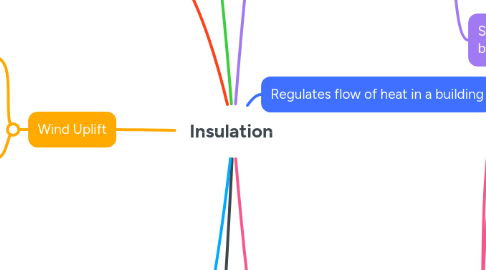
1. Regulates flow of heat in a building
2. Tapered Insulation
2.1. Creates slopes on decks with insufficient slope
2.2. Types
2.2.1. AA
2.2.1.1. 0.5" - 1"
2.2.2. A
2.2.2.1. 1" - 1.5"
2.2.3. B
2.2.3.1. 1.5" - 2"
2.2.4. C
2.2.4.1. 2" - 2.5"
2.3. Higher slopes add a 2" filler underneath
3. General
3.1. Place insulation in two layers
3.1.1. Prevents thermal bridging
3.1.1.1. Heat loss through gaps
3.1.2. Can fasten bottom, adhere top
3.1.3. Prevents cantilevering
3.1.3.1. Ending insulation on low point of metal deck
3.2. Nailing strips required on slopes over 1 in 12
3.3. Nailed insulation - 2" max
3.4. Minimum 12" stagger
4. Fastening
4.1. Mechanical fasteneing requirements for full 4'x 8' sheet
4.1.1. Field
4.1.1.1. 8 Fasteners
4.1.2. Edge
4.1.2.1. 12 Fasteners
4.1.3. Corner
4.1.3.1. 15 Fasteners
4.2. Fasteners must penetrate deck 3/4"
4.3. Asphalt Adhering
4.3.1. Insulation no more than 4'x 4'
4.3.2. "Mop and Flop" coverboard
4.3.2.1. Mop coverboard with asphalt, lay onto heat sensitive insulation
4.4. Foam Adhesive
4.4.1. Ribbon Spacing
4.4.1.1. Field: 12"
4.4.1.2. Edge: 6"
4.4.1.3. Corner: 4"
5. Wind Uplift
5.1. Air pressure below roof system higher than above
5.2. Wind uplift zones
5.2.1. Field
5.2.1.1. Interior of roof
5.2.2. Edge
5.2.2.1. Perimeter of roof
5.2.2.1.1. 10% of building width, 40% of building height, whichever lower
5.2.3. Corner
5.2.3.1. Corner sections of perimeter
5.2.3.1.1. Not less than 7'x 7'
6. Vapour Barrier
6.1. Water vapour
6.1.1. Reduces insulation R-value
6.1.2. Causes rot and mould
6.1.3. Causes water damage to building
6.2. Installed on walls, ceilings and floors
6.3. Prevents vapour from entering roofing system
6.3.1. Vapour Retarder provides protection
6.3.2. Vapour Barrier completely prevents moisture
6.3.3. Various classes of permeability
6.3.3.1. Class 1
6.3.3.1.1. Sheet Metal
6.3.3.1.2. Rubber membrane
6.3.3.2. Class 2
6.3.3.2.1. Kraft Paper
6.3.3.2.2. EPS
6.3.3.2.3. XPS
6.3.3.3. Class 3
6.3.3.3.1. Gypsum Board
6.3.3.3.2. Fibreglass insulation
6.3.3.3.3. Board lumber
6.4. All laps and penetrations sealed 100%
6.4.1. Most issues caused by air leakage, not vapour diffusion
6.5. Should be placed on warm side of building
6.5.1. Outside insulation in warm climates or cold buildings
6.5.2. Under insulation in cool climates
7. Insulation Materials
7.1. R-value: Resistance to heat
7.2. Expanded Polystyrene (EPS)
7.2.1. R-value: 3.75 - 4.25
7.2.2. Heat sensitive
7.3. Expanded Extruded Polystyrene (XPS)
7.3.1. R-value: 4.75 - 5
7.3.2. Heat sensitive
7.3.3. Type 4 is used in PRMA
7.4. Polyisocyanurate (ISO)
7.4.1. R-value: 5.75
7.4.2. Not heat sensitive
7.5. Mineral Wool
7.5.1. R-value: 3.5
7.5.2. Not sensitive to heat
7.5.3. Resistant to flame, can be torched directly to
7.6. Perlite
7.6.1. R-value 2.78
7.6.2. Heat insensitive, flame resistant
7.6.3. Made from volcanic glass
7.7. Phenolic
7.7.1. Can corrode metal if moisture enters system
7.8. Asbestos
7.8.1. Destroys your lungs
7.8.2. Buildings built before 1990 should be tested
7.9. Fibreboard
7.9.1. Very flammable
7.9.2. Can smolder for hours before igniting
8. Coverboard
8.1. Protects insulations
8.1.1. Mechanical damage
8.1.2. Heat damage
